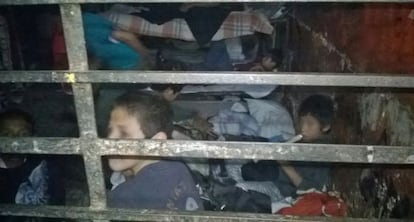Terror at Mamá Rosa’s house
Mexican police accuse well-known educator of keeping hundreds of children in slave-like conditions


This horror story was set in the Mexican city of Zamora (Michoacán). There, in Mamá Rosa’s House, 592 people lived in overcrowded rooms under slave-like conditions. According to the Attorney General’s Office, some were children who had been abandoned and others were teenage delinquents. The police freed the alleged captives earlier this week and revealed a catalogue of abuses that would make Charles Dickens turn pale. Many of the minors were left to the care of the director of the shelter, Rosa del Carmen Verduzco, a 79-year-old woman who made them beg door-to-door and in the streets. Verduzco allegedly fed them poorly and did not have enough beds for them to sleep on. Some boarders were even sexually abused.
The worst of these offenses was the grim tradition authorities revealed: children born in the shelter were, all of them fruits of misery, registered as the sons and daughters of the foundation’s owner, preventing the parents from making any decisions concerning the little ones. This scheme was the switch that set off the investigation at the Prosecutor General’s Office. At least five parents reported kidnappings (years after they had given the children to the foundation) and what was until then a rumor led to a joint military and federal police operation. The authorities arrested Verduzco and eight of her employees. The operation pulled 452 minors out of the home – 278 boys and 174 girls, including six babies. They also found 138 men and women aged between 18 and 40.
Still, the question remains: how could a well-known institution housing hundreds of boarders and working under signed agreements with public entities have committed so many offenses without anyone stepping in before now?
The shelter known as La Gran Familia opened in 1947. It was run like a boarding house. Its image in the press was almost beatific. Its employees held classes for the city’s needy children, from kindergarten to high school. The foundation worked under agreements with the public education board. It also offered art, music, sewing and bricklaying workshops. Rosa del Carmen “The Boss” Verduzco, presented herself on the institution’s Facebook page as “the mother” of all the boarders and said that she had adopted them out of love. “Delinquents, drug addicts or street kids – all of them have the last name Verduzco,” she says in a note on that page. “My life is dedicated to the education of those kids,” Verduzco has said on various occasions. The actual number of children she has adopted is a mystery.
Former presidents Vicente Fox and Felipe Calderón even visited the center. Queen Elizabeth II of England funded its gymnasium. The shelter was well-known and it had earned the respect of many intellectuals for responding to the needs of those helpless children where the state did not. It’s worth nothing that when the police operation was announced, thinkers such as Enrique Krauze asked people on social media platforms to show respect for Verduzco.
Overnight, this woman has gone from venerable educator to ogre. She had been taking care of children for 60 years. “Thousands of kids have gone through that place. There may be some outrageous cases, but we cannot throw aside all she did in education,” says a person familiar with the shelter. “This is an exaggeration. I’ve known the house since 1979 and it’s an extraordinary institution, a permanent miracle,” says Jean Meyer, the well-known historian.
The story the police and the Prosecutor General’s Office offered, however, gives no such hope. The investigation has collected testimonials that detail all kinds of abuse. Attorney General Jesús Murillo Karam said one of the victims told authorities that she was not allowed to leave after turning 18 and that she was forced to work without pay at the institution for another 13 years. The same woman said Mamá Rosa later adopted her children and she could only see them once every two months for three hours. In her despair, this mother offered The Boss 10,000 pesos to give her back her daughters. According to Murillo Karam, Verduzco said: “Get the money ready and call me.”
Mamá Rosa was hospitalized after her arrest. Two of the five girls who were allegedly kidnapped have been found. The police are looking for three more while they identify the boarders. Meanwhile, authorities have started to fumigate the center because of rat, bedbug and flea infestations.
Translation: Dyane Jean François
“I don’t want this girl. Do you want her?”
"I don't want this girl. Do you want her?" A single mother suffering from a severe mental illness had just tried to end her premature baby's life. Rosa del Carmen Verduzco, a 22-year-old primary school teacher who had rushed to the hospital after her friend, a priest, told her about the case, was standing in front of that mother. At that moment in 1957, an idea struck this devoted young woman who had dedicated her life to the care of abandoned children. She took the baby in her arms and went to the Civil Registry office. She registered him as her own natural born son. Under the father's information, she put "father unknown." Mamá Rosita was born. A kaleidoscopic character that inspires passion just as much as she draws suspicion and rancor.
Over the years, what began as an act of exceptional charity has become a long-standing tradition. Verduzco openly adopted babies, twins, triplets, and individuals of age, creating a core support group around La Gran Familia that is famous in all of Mexico. La Gran Familia has never been far from controversy.
On its website, Verduzco acknowledges that she disciplined minors "sometimes in a dictatorial manner" and that she made them work at a young age. "The older ones harvested strawberries and sold newspapers in order to bring some money home. Sometimes there wasn't enough for food."
The shelter grew on that foundation and, by the early 1970s, Mamá Rosa was already in charge of 40 adopted children. She then bought 8,000 square meters to build her establishment. The little ones had to work hard to build that center. "The nine-year-olds made bricks and the six-year-olds would carry them." That burgeoning community made up for the state's lack of services and grew. In 1973, it became a civic organization. Its connections in the network of social assistance and public education programs in Michoacán ran deep. Presidents, senators, deputies and intellectuals visited the center. Some, like the prestigious historian Enrique Krauze, wrote about Verduzco. Her work in education was the toast of all social service organizations.
"This is a case of government harassment of a person who has dedicated her life to taking in orphans," Krauze said on Twitter. The government's operation seems excessive in the eyes of many who have visited the shelter. "Why did they need the military? They have treated her like a drug trafficker," a person familiar with the center says.
La Gran Familia has sheltered 4,000 kids, served the community for several decades and lived through many experiences. Now this unusual institution faces suspicion and harsh accusations. However things work out, a scandal is set to explode.
Tu suscripción se está usando en otro dispositivo
¿Quieres añadir otro usuario a tu suscripción?
Si continúas leyendo en este dispositivo, no se podrá leer en el otro.
FlechaTu suscripción se está usando en otro dispositivo y solo puedes acceder a EL PAÍS desde un dispositivo a la vez.
Si quieres compartir tu cuenta, cambia tu suscripción a la modalidad Premium, así podrás añadir otro usuario. Cada uno accederá con su propia cuenta de email, lo que os permitirá personalizar vuestra experiencia en EL PAÍS.
¿Tienes una suscripción de empresa? Accede aquí para contratar más cuentas.
En el caso de no saber quién está usando tu cuenta, te recomendamos cambiar tu contraseña aquí.
Si decides continuar compartiendo tu cuenta, este mensaje se mostrará en tu dispositivo y en el de la otra persona que está usando tu cuenta de forma indefinida, afectando a tu experiencia de lectura. Puedes consultar aquí los términos y condiciones de la suscripción digital.








































